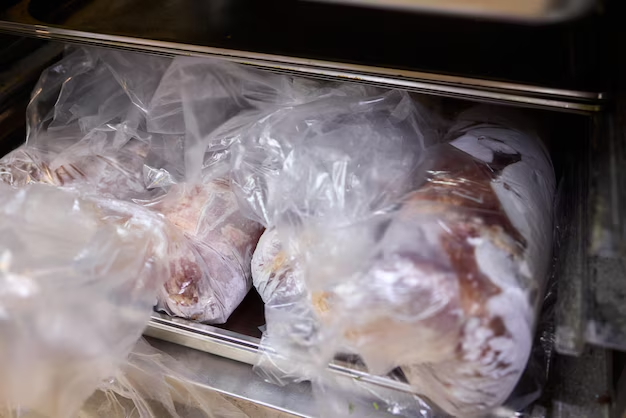The Ultimate Guide to Storing Chicken in Your Refrigerator: Ensuring Freshness and Safety
When it comes to storing chicken in your refrigerator, many people find themselves asking where exactly it should be placed to ensure it remains fresh and safe for consumption. Proper storage is crucial, not just for taste but for health safety as well. Let’s dive into the best practices, common pitfalls, and related tips for storing chicken in your fridge. 🐔🥶
Why Proper Storage Matters
Chicken, like other poultry, is highly perishable and prone to bacterial growth. Proper storage helps prevent foodborne illnesses and spoilage. By understanding how to store chicken correctly, you can maximize its shelf life and maintain its quality.
Common Risks of Improper Storage
- Bacterial Contamination: Raw chicken can be a breeding ground for harmful bacteria like Salmonella and Campylobacter.
- Cross-Contamination: Poor storage can lead to contamination of other food items, which can spread bacteria.
- Spoilage: Incorrect storage practices can lead to premature spoilage, resulting in food waste.
Where in the Refrigerator Should the Chicken Be Stored?
The ideal spot for storing chicken is on the bottom shelf. Here’s why this simple practice is a game-changer:
Why the Bottom Shelf?
- Temperature Consistency: Refrigerators vary in temperature, and the bottom shelf typically maintains a more consistent temperature, which is vital for raw meats.
- Preventing Drips: Storing chicken on the bottom shelf ensures that any juices do not drip onto other foods, which could lead to contamination.
- Ease of Access for Safe Handling: Positioning chicken on the bottom shelf makes it easier to handle and contain, reducing the risk of accidents.
Additional Storage Tips
- Use Airtight Containers: Always store chicken in airtight containers or sealable plastic bags to prevent air exposure and minimize the risk of leaks.
- Label and Date: Clearly label and date the containers to keep track of how long the chicken has been stored.
- Separate from Other Foods: Keep chicken separate from ready-to-eat foods to prevent cross-contamination.
Understanding the Optimal Temperature for Storing Chicken
Keeping the refrigerator at the correct temperature is essential for food safety.
Recommended Temperature
- Maintain a Temperature Below 40°F (4°C): This is considered the safe temperature threshold to inhibit bacterial growth.
Monitoring the Temperature
- Use a Refrigerator Thermometer: Not all refrigerators maintain a constant temperature, so a thermometer helps ensure it remains at a safe level.
The Importance of Proper Packaging
Packaging plays a critical role in preserving the quality of chicken while avoiding contamination.
Choosing the Right Packaging
- Vacuum-Sealed Bags: These are excellent for minimizing air exposure and extending shelf life.
- Plastic Wrap and Foil: Useful for additional protection when combined with airtight containers.
Packaging Tips
- Double Wrap: Especially if the chicken has a strong odor, double wrapping can prevent it from affecting the refrigerator's smell or other foods.
- Check for Tears or Holes: Always inspect packaging for damage to ensure no exposure to air or contaminants.
Raw vs. Cooked Chicken: Different Storage Needs
Storing Raw Chicken
- Shelf Life: Raw chicken should ideally be used within 1-2 days for best quality.
Storing Cooked Chicken
- Shelf Life: Cooked chicken can generally be stored for 3-4 days.
- Containers Matters: Use shallow containers to cool the chicken more quickly and evenly.
Handling Expired Chicken
If chicken has exceeded its recommended storage period, it should be discarded to avoid health risks.
How to Identify Spoilage
- Smell: A sour or ammonia-like smell is a clear sign of spoilage.
- Texture: Slimy or sticky texture is another indication that the chicken is no longer safe to eat.
- Color: Discoloration, such as gray or green tones, suggests that the chicken has gone bad.
A Quick-Reference Guide to Optimal Chicken Storage
🔍 Quick Tips for Storing Chicken:
- 🌬️ Temperature: Keep below 40°F (4°C)
- 🗓️ Shelf Life: Raw (1-2 days), Cooked (3-4 days)
- ⬇️ Storage Location: Bottom shelf, wrapped securely
- 🍗 Packaging: Use airtight containers or vacuum-sealed bags
- 🚫 Spoilage Check: Look for odor, slimy texture, discoloration
Related Food Storage Practices: Beyond Chicken
While chicken may be your primary concern, understanding broader food storage practices can ensure overall kitchen safety and efficiency.
Meat Storage Hierarchy
- Top Shelf: Ready-to-eat foods
- Middle Shelf: Dairy products and eggs
- Bottom Shelf: Raw meats, including chicken
- Crisper Drawers: Fruits and vegetables
Use-by vs. Best Before
Understanding the difference between "use-by" and "best before" dates helps in maximizing the usage of your kitchen items while ensuring safety.
- Use-by: Indicates safety; consumption after this date could be risky.
- Best Before: Relates to quality rather than safety; food typically remains safe to eat beyond this date if stored correctly.
Closing Notes on Storing Chicken
Ensuring chicken is stored correctly in the refrigerator not only preserves its flavor and texture but is also critical for preventing foodborne illnesses. By following the guide provided above, you can make informed decisions that safeguard your family's health while keeping food waste to a minimum. Remember to routinely check your refrigerator setup, label your foods, and be mindful of shelf life for a safer, healthier kitchen. 😊🏠
Use this guide as your go-to resource for handling and storing chicken, ensuring that every meal you prepare is both delicious and safe.
